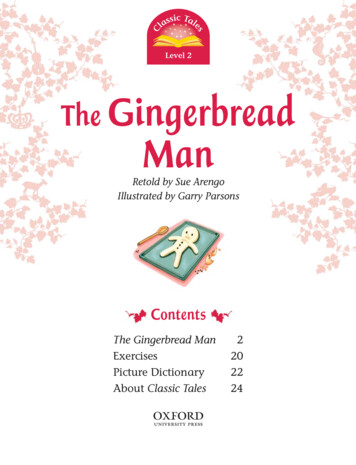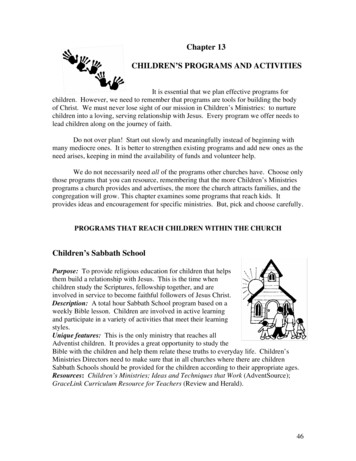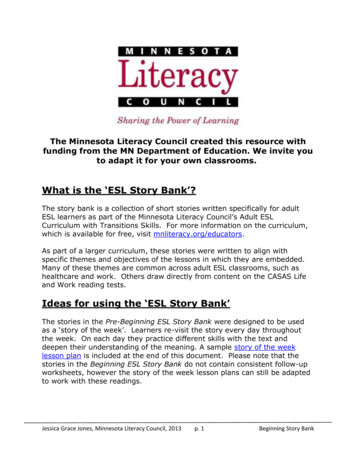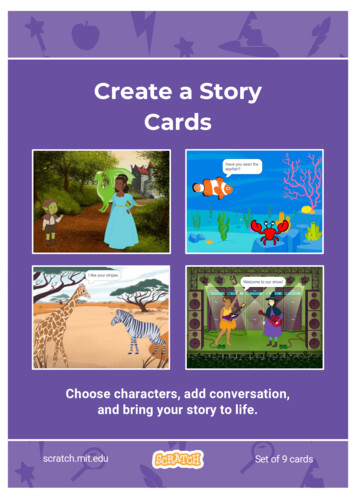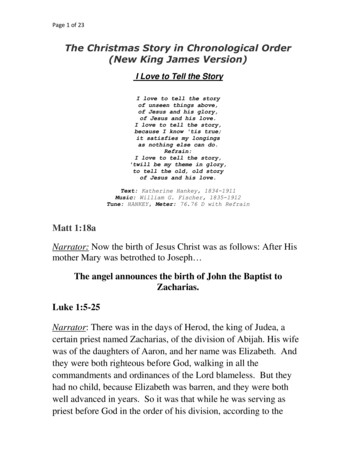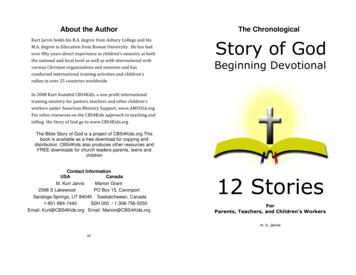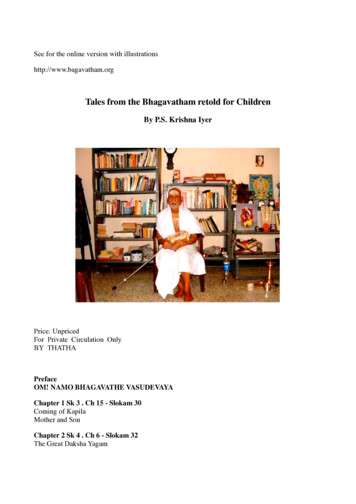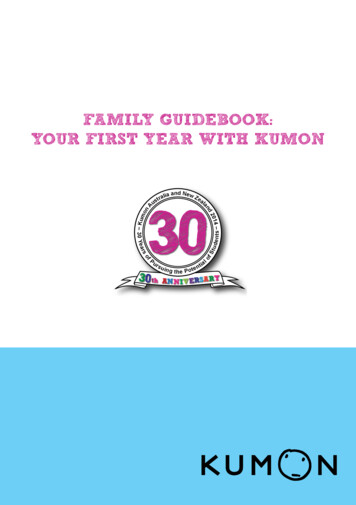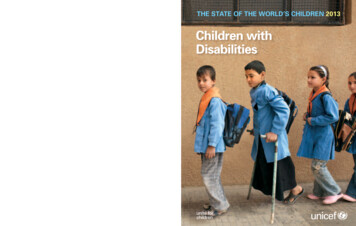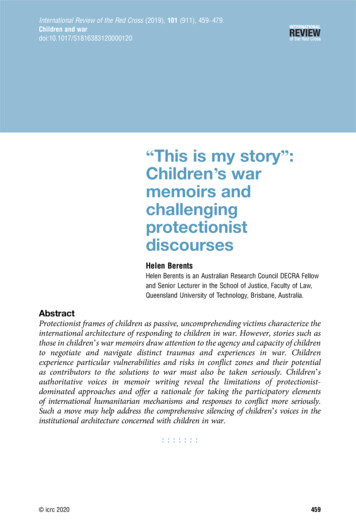
Transcription
International Review of the Red Cross (2019), 101 (911), 459–479.Children and wardoi:10.1017/S1816383120000120“This is my story”:Children’s warmemoirs andchallengingprotectionistdiscoursesHelen BerentsHelen Berents is an Australian Research Council DECRA Fellowand Senior Lecturer in the School of Justice, Faculty of Law,Queensland University of Technology, Brisbane, Australia.AbstractProtectionist frames of children as passive, uncomprehending victims characterize theinternational architecture of responding to children in war. However, stories such asthose in children’s war memoirs draw attention to the agency and capacity of childrento negotiate and navigate distinct traumas and experiences in war. Childrenexperience particular vulnerabilities and risks in conflict zones and their potentialas contributors to the solutions to war must also be taken seriously. Children’sauthoritative voices in memoir writing reveal the limitations of protectionistdominated approaches and offer a rationale for taking the participatory elementsof international humanitarian mechanisms and responses to conflict more seriously.Such a move may help address the comprehensive silencing of children’s voices in theinstitutional architecture concerned with children in war. icrc 2020459
H. BerentsIntroduction“Who is Malala?” [the man] demanded. My friends say he fired three shots,one after another. By the time we got to the hospital my long hair andMoniba’s lap were full of blood. Who is Malala? I am Malala and this is mystory.1So concludes the prologue to I Am Malala, the memoir of Malala Yousafzai, thePakistani girl who campaigned for education in the Swat Valley and was shot bythe Taliban at age 15 in October 2012. Yousafzai frames the book as a story of aspecific experience of conflict and its consequences. Sudanese former child soldierEmmanuel Jal prefaces his book, War Child, by noting that “this one is notmeant to be a history of a country to be read by scholars. It is the story of oneboy, his memories, and what he witnessed.”2 Seventeen-year-old Syrian refugeeNujeen Mustafa says:I hate the word refugee more than any word in the English language. Theyear 2015 was when I became a fact, a statistic, a number. Much as I likefacts, we are not numbers, we are human beings and we all have stories. Thisis mine.3The genre of children’s war memoir is growing in popularity in literary publishing.Narratives of children’s experiences of war, such as a memoir, open space toovercome the distance and abstraction of numbers. Thus, this article argues thatsuch stories offer a counter-narrative to dominant framings of children in war aspassive victims. Children’s war memoirs show children who, even when violenceand conflict overwhelm their lives, find ways of navigating, resisting, survivingamidst conflict. Such memoirs reflect how ideas of children and childhood areconstructed, reveal “cultural spaces available to host and circulate thesenarratives”4 and are fundamentally located in a space of “struggle for recognitionof individuals and groups”5. Thus, they can reveal complex aspects of children’sexperiences of war that offer a rich resource for better understanding children’slives in war and possibilities for better addressing violence and supporting peace.Protracted conflict, increasingly urbanized warfare6 and unprecedentedforced displacement around the world7 present a particularly challenging1234567460Malala Yousafzai and Christina Lamb, I Am Malala: The Girl Who Stood Up for Education and Was Shotby the Taliban, Weidenfeld & Nicolson, London, 2013, p. 6.Emmanuel Jal and Megan Lloyd Davies, War Child: A Child Soldier’s Story, St Martins Griffin, New York,2009.Nujeen Mustafa and Christina Lamb, Nujeen: One Girl’s Incredible Journey from War-Torn Syria in aWheelchair, William Collins, London, 2016, p. 12.Kate Douglas, Contesting Childhood: Autobiography, Trauma, and Memory, Rutgers University Press,New Brunswick, 2010.Gillian Whitlock, Soft Weapons: Autobiography in Transit, University of Chicago Press, Chicago, IL, 2010.Vincent Bernard, “Editorial: War in Cities”, International Review of the Red Cross, Vol. 98, No. 901, 2016.Office of the UN High Commissioner for Refugees, Global Trends: Forced Displacement in 2017, Geneva,25 June 2018; Vincent Bernard, “Migration and Displacement: Humanity with its Back to the Wall”,International Review of the Red Cross, Vol. 99, No. 904, 2017.
“This is my story”: Children’s war memoirs and challenging protectionist discoursesenvironment for children and for efforts to protect and empower them. The UnitedNations (UN) Secretary-General’s 2018 Annual Report on Children in ArmedConflict noted that “children continue to be disproportionately affected by armedconflict in many country situations”, with a significant increase in violencethrough 2017 compared to the previous year.8 Shifting patterns of conflict since2016 have seen children increasingly caught up in violence, including recruitmentby armed groups in countries such as the Democratic Republic of the Congo,Somalia, the Syrian Arab Republic, Yemen and South Sudan.9 Ongoing violencein the Syrian Arab Republic, Iraq, Myanmar and other countries has resulted inthe death, maiming, starvation and serious illness of large numbers of children.10The use of children by terrorist groups such as Boko Haram and the IslamicState, including as suicide bombers,11 presents new challenges in responding tothe multiple and complex forms of violence and risk that children face.The difficult and complex environments of conflicts have a profound effecton those who live within these spaces. Children actively resist war and go on livingamongst its daily consequences. Despite this, their agency is largely absent whenspeaking about children and war. Their overwhelming, and pressing, requirementsfor safety, shelter, food and health care, as well as the longer-term needs ofeducation and employment, dominate discussions of children’s experiences ofconflict, and position them as passive. Such totalizing narratives of victimhoodobscure and homogenize the complexity of the lived experience of children in war.Legal and humanitarian mechanisms for assisting children in war, including the UNConvention on the Rights of the Child (CRC), the Geneva Conventions and theChildren and Armed Conflict Agenda, are characterized by a protectionist discoursewhich limits capacity for understanding multiplicity of experience. Saying this is notto dismiss the significant role these documents and practices have in productivelysupporting children in conflict, but rather to ask what other experiences of warchildren have, and what other forms of support they require. To fully understandthe implications of children’s experiences of conflict, we must consider thepersistent everyday lives of those within conflict zones not reducible to either“victim” or “combatant”. As children’s agency is often erased in formal discussionsof preventing or resolving conflict, accounts of their experiences of everyday life canoffer a way of recognizing their capacity and legitimating their voice and experience,particularly when produced for mass literary markets. Taking lived experience asmeaningful helps in understanding how children experience conflict and suggestsways for working with them for change. It is difficult for these stories to be heard8Annual Report of the Secretary-General on Children and Armed Conflict, UN Doc. A/72/865-S/2018/465,16 May 2018, para. 5.9 Watchlist on Children and Armed Conflict, A Credible List: Recommendations for the 2018 Annual Reporton Children and Armed Conflict and Listings, March 2018, available at: hlist-policy-note web.pdf (all internet references were accessed in August 2018).10 Annual Report of the Secretary-General, above note 8.11 John G. Horgan, Max Taylor, Mia Bloom and Charlie Winter, “From Cubs to Lions: A Six Stage Model ofChild Socialization into the Islamic State”, Studies in Conflict & Terrorism, Vol. 40, No. 7, 2017.461
H. Berentsbeyond zones of conflict which are distant from the realities of many people’s livesglobally, particularly in the global North.This article considers the particular example of child-owned and -authorednarratives of war in order to discuss the limits of protectionist framings andillustrate its argument for taking children’s experiences seriously. Narrativesproduced by children offer a different way of thinking about children in conflict.The article takes children’s war memoirs as an example of the value andcomplexity of children’s own narratives. As a form of popular literature, theyoffer a way of accessing the detail of children’s daily experiences of conflict.Thus, this article suggests that children’s war memoirs offer a site where thecomplexities of children’s experiences of conflict are visible and accessible to abroad popular audience. Taking such accounts seriously can offer a productiveway of thinking about children’s agency in war that can inform discussions aboutinstitutional architecture and humanitarian interventions.This article illustrates its argument by considering a range of popularchildren’s war memoirs. This includes stories of former child soldiers such asSierra Leonean Ishmael Beah’s 2007 A Long Way Gone12 and Emmanuel Jal’s2009 account of his time in the Christian Sudanese Liberation Army, WarChild,13 as well as the 2015 I Am Evelyn Amony,14 which recounts EvelynAmony’s time with the Lord’s Resistance Army (LRA) and as the wife of LRAleader Joseph Kony. It also includes stories of those who have lived through andescaped from war such as Syrian refugee Nujeen Mustafa’s 2016 Nujeen, tellingthe story of her journey to Europe in a wheelchair to escape Syria’s civil war, and8-year-old Syrian Bana Alabed’s 2017 Dear World,15 which began as live tweetsfrom Aleppo during the 2016 siege. Finally, it includes, from 2013, I Am Malala16by Malala Yousafzai, telling of a young woman’s activism against extremism. Thisis a non-exhaustive collection of children’s war memoirs, chosen to illustrate abreadth of experience and selected due to popular reception to these stories.In discussing children’s war memoirs as a source of knowledge aboutconflict that centres the capacity and agency of the child and may offer oneavenue for considering how such agency can be better accounted for in formalresponses to children in conflict, there is an important consideration of the ethicsof “using” these texts, analyzing them, bringing them in to broader debate.1712 Ishmael Beah, A Long Way Gone: Memoirs of a Boy Soldier, Farrar, Straus and Giroux, New York, 2007.13 E. Jal and M. Lloyd Davies, above note 2.14 Evelyn Amony and Erin Baines, I Am Evelyn Amony: Reclaiming My Life from the Lord’s Resistance Army,University of Wisconsin Press, Madison, WI, 2015.15 Bana Alabed, Dear World: A Syrian Girl’s Story of War and Plea for Peace, Simon & Schuster, London,2017.16 M. Yousafzai and C. Lamb, above note 1.17 This article does not look at fictional stories of children in war such as the filmic depiction of child soldiersin Blood Diamond (2006) or Beasts of No Nation (2015). Nor does it explore stories told about childrensuch as through NGO advocacy or journalism, as these are stories told without the participation ofchildren, which is central to the discussion (see Jana Tabak and Leticia Carvalho, “Responsibility toProtect the Future: Children on the Move and the Politics of Becoming”, Global Responsibility toProtect, Vol. 10, No. 1–2, 2018). The article also does not look at visual depictions by children or“children’s stories” told through images of children such as the image of Syrian toddler Alan Kurdi’s462
“This is my story”: Children’s war memoirs and challenging protectionist discoursesKate Douglas, writing in her scholarly discipline of literary studies, offers anincisive consideration of the ethics of considering trauma texts authored by youngpeople, calling for the need to “find appropriate methods for reading these textswithin diverse disciplinary and scholarly contexts”.18 She draws attention to howthe narratives of these texts may be taken up in ways that are potentiallydamaging and reflects on the intersectional imbalances of power and voice intheir production. More crucially, she asks scholars to reflect on their engagementwith accounts of trauma. While this article cannot delve into the content of thesememoirs as much as desired due to space limitations (and as it is not a literarystudies analysis but one grounded in international relations), I am profoundlyconscious of not reproducing the worst forms of superficial analysis or unethicalengagement with the texts considered here.Children’s capacity is often excluded in dominant narratives of theirexperiences of war; this article suggests that children’s war memoirs can work tocomplicate such simple narratives. This article first unpacks the dominantnarrative of passivity and totalizing victimhood that characterizes much framingof children’s experiences of war; it argues that such a framing limits our capacityto fully understand children’s experiences and narrows possible responses andsupport for children affected by conflict. This limited conception of childhood isevident in the protectionist framing of the UN’s Children and Armed Conflictagenda, as well as much of non-governmental organizations’ (NGO) advocacy.Instead, this article argues that recognizing children as having agency andworking to respond to violence and navigate conflict allows children’s stories tobe seen as a legitimate source of knowledge about conflict. Building on this, thearticle secondly outlines an argument for recognizing the importance of everydayaccounts in constructing fuller and more responsive understandings of conflict.Having demonstrated that the agency of children should be consideredmore critically, the article turns to consider the role of children’s war memoirs asa powerful, culturally recognized space for children’s voices in accounts of war. Itargues that memoir can be seen as one site where children’s agency in war isevident. Such books offer stories of agency, resiliency and meaning-making bychildren affected by war, demonstrating the diverse ways children are affected byand navigate armed conflict. Children’s authoritative voice in memoir writingreveals the limitations of protectionist-dominated approaches and offers arationale for taking the participatory elements of international human rightsmechanisms and responses to conflict more seriously. Through theseexplorations, this article argues for taking children’s own stories of conflict intodeath on a Turkish beach, although the visual is an important site in both fictional and non-fictionaldepictions of children in conflict (see Helen Berents, “Apprehending the ‘Telegenic Dead’: ConsideringImages of Dead Children in Global Politics”, International Political Sociology, Vol. 13, No. 2, 2019;Heide Fehrenbach and Davide Rodogno, “‘A Horrific Photo of a Drowned Syrian Child’:Humanitarian Photography and NGO Media Strategies in Historical Perspective”, International Reviewof the Red Cross, Vol. 97, No. 900, 2015). All these sites are important additional spaces where thestories and voices of children might be productively explored.18 Kate Douglas, “Ethical Dialogues: Youth, Memoir, and Trauma”, a/b: Auto/Biography Studies, Vol. 30, No.2, 2015, p. 273.463
H. Berentsaccount in order to help move towards addressing the systematic andcomprehensive silencing of children’s voices in the institutional architectureconcerned with children in war.Children’s vulnerabilityDefinitions of childhood are contested, but there is a broad consensus thatchildhood is the period from birth to 18 years of age. At the most basicdefinitional level, the CRC defines a child as “every human being below the ageof eighteen unless, under the law applicable to the child, majority is attainedearlier”.19 While in some legal and cultural systems, different competencies arerecognized before (and sometimes after) the age of 18 – such as voting, purchaseand consumption of alcohol or tobacco, age of consent for sexual activities, andlegal accountability – at some point every society recognizes a person astransitioning from childhood to a “competent adult”. The notion of the child thatdominates in popular discourse and underpins international conventions such asthe CRC is presented as universal but is in fact the product of Westernphilosophical, psychological and sociological thought: an incomplete, irrational“becoming”20 who is the passive recipient of socialization and a site ofinvestment for the future.21 Thus, childhood can be understood as the conditionexperienced by all children,22 and their passivity and incompleteness justifies theprotectionism of the family, concerned institutions, the State and the internationalcommunity.23 Removing children from the public sphere and legislating an“appropriate place” for children reinforces their incomplete status and legitimizestheir marginal condition and silencing. They are often seen as “presocial”, whichprecludes them from being able to articulate political or social positions.24Brocklehurst argues that there is a “conceptual separation” of the child and thepolitical, a “containment” of the concept of the child as specifically not political.25This also allows the child to be deployed as a motivation for political action (forexample, as an emotive symbol) when necessary.19 Convention on the Rights of the Child, 20 November 1989 (entered into force 2 September 1990), Art. 1.20 Jens Qvortrup, “Childhood Matters: An Introduction”, in Jens Qvortrup, Marjatta Bardy, Giovanni Sgrittaand Helmut Wintersberger (eds), Childhood Matters: Social Theory, Practice and Politics, Avebury,Aldershot, 1994.21 Allison James, Chris Jenks, and Alan Prout, Theorizing Childhood, Teachers College Press, TeachersCollege, Columbia University, New York, 1998.22 Tobias Hecht, At Home in the Street: Street Children of Northeast Brazil, Cambridge University Press,Cambridge, 1998.23 Olga Nieuwenhuys, “Growing Up between Places of Work and Non-Places of Childhood: The UneasyRelationship,” in Karen Fog Olwig and Eva Gulløv (eds), Children’s Places: Cross-Cultural Perspectives,Routledge, London, 2003, p. 99.24 D. Sears and N. Valentino, “Politics Matters: Political Events as Catalysts for Pre-AdolescentSocialisation”, American Political Science Review, Vol. 91, No. 1, 1997.25 Helen Brocklehurst, Who’s Afraid of Children? Children, Conflict and International Relations, Ashgate,Aldershot, 2006, p. 140.464
“This is my story”: Children’s war memoirs and challenging protectionist discoursesIn being located in the passive, private sphere against the public, politicalworld, the child is prevented from participating or speaking. Moreover, thedominant discourse delegitimizes any attempt by children to speak for themselves. Itplaces “the child” in front of the multiplicity of experiences and institutionalizes thedominant conception of childhood. The concept of “children” as seen by adultsmay not reveal the lived experience of young people themselves, a “phenomenonof duality and misrepresentation which is unique to this cohort, since they cannotrepresent themselves”.26 Cordero Arce points out that children are considereddependent, incompetent and irrational, not because they actually are any of thesethings, but because adults acknowledge children only as lacking competency andrationality; furthermore, he notes that “the child” embodies a whole set of ideasthat reinforce this formalized adult “knowing”.27These cultural norms of childhood, even when not in conflict zones, limitchildren’s agency and prevent them from being seen as competent contributors tocommunities and societies.28 In conflict, children are often characterized inherentlyas victims. They are not seen as having agency, and thusmost approaches to building peace marginalize issues surrounding children:they are little discussed in peace-building policies, seldom asked to participatein peace-building projects, and peace-building strategies are rarely informedby knowledge regarding either their wartime experiences or their post-conflictneeds.29Children in conflict zones, therefore, may be perceived by aid and developmentagencies and collective public understandings as “the ultimate victim”.30 Childhoodhas been “decontextualized” and is characterized by “dependence and vulnerability”.31As a result, children in conflict environments are portrayed as beingconsistently, and universally, negatively affected. With their childhoods “lost” or“stolen”, children in these environments are seen as either dangerous delinquentsto be reformed or innocent victims to be protected. Adults label former childcombatants as “out-of-place” and dangerous because they have transgressed whatis seen as appropriate behaviour and appropriate place for a child or youngperson. Additionally, the presence of large youth populations is constructed as a26 Ibid., p. 21.27 Matías Cordero Arce, “Towards an Emancipatory Discourse of Children’s Rights”, International Journalof Children’s Rights, Vol. 20, No. 3, 2012, p. 379.28 Michael Wyness, Lisa Harrison and Ian Buchanan, “Childhood, Politics and Ambiguity: Towards anAgenda for Children’s Political Inclusion”, Sociology, Vol. 38, No. 1, 2004; Alison James and AlanProut (eds), Constructing and Reconstructing Childhood: Contemporary Issues in the Sociological Studyof Childhood, Falmer Press, Basingstoke, 1990; Jo Boyden, “Children under Fire: ChallengingAssumptions about Children’s Resilience”, Children, Youth and Environments, Vol. 13, No. 1, 2003;Nick Lee, Childhood and Society: Growing Up in an Age of Uncertainty, Open University Press,Buckingham, 2001.29 Alison M. S. Watson, “Can there Be a ‘Kindered’ Peace?”, Ethics and International Affairs, Vol. 22, No. 1,2008.30 Alison M. S. Watson, “Resilience is Its Own Resistance: The Place of Children in Post-ConflictSettlement”, Critical Studies on Security, Vol. 3, No. 1, 2015, p. 51.31 J. Boyden, above note 28, p. 1.465
H. Berentsthing to fear.32 Alternatively, children are constructed as passive victims, seen as theunwilling and uncomprehending tool of vicious regimes33 or the unwitting suffererof tragic circumstance. Thus, collectively, young people are frequently portrayed asdangerous; individually they are seen as in need of care and protection.Yet, a compelling and every-growing body of detailed research evidencedemonstrates that children are not merely or solely victims or delinquents. In1990, James and Prout identified the key features of the “emergent paradigm” ofresearch and researchers committed to recognizing children in their own right.34They argue that while children are still in a process of development, theirexperiences are not invalidated because of this. They note that childhood can beunderstood as a social construction, contingent on geographic and historicallocation; comparative analysis demonstrates a multiplicity of childhoods that runcounter to the notion of a universal construction. Those researchers adopting andcontributing to this view see children as active in the construction of their ownsocial lives. Young people thus acquire a form of full social position, different ineach society, whereby they occupy “subordinate positions within the socialstructure as ‘dependent beings’ rather than ‘dependent becomings’”.35In conflict contexts, children act to negotiate the difficulties they encounter.This includes joining but also escaping from armed groups, supporting their familiesfinancially and taking on head-of-household roles, and persisting to pursue theireducation when possible. They also have their own opinions on the state ofnational or local politics, mourn and grieve for loss, and navigate insecure andviolent contexts.36 In Colombia, children affected by the conflict, living asinternally displaced people in informal communities, position themselves asactive in daily efforts to mitigate violence and construct strong community.37Finnstrom’s work in Uganda demonstrates that child rebels do not positionthemselves as passive but rather negotiate, as actors with agency, their owncircumstances.38 Similar examples are evident in other environments.39 In conflict32 Siobhán McEvoy-Levy, “Conclusion: Youth and Post-Accord Peace Building”, in Siobhán McEvoy-Levy(ed.), Troublemakers or Peacemakers? Youth and Post-Accord Peace Building, University of Notre DamePress, Notre Dame, IN, 2006, p. 282.33 Vanessa Pupavac, “Misanthropy without Borders: The International Children’s Rights Regime”, Disasters,Vol. 25, No. 2, 2001.34 A. James and A. Prout (eds), above note 28.35 N. Lee, above note 28, p. 47.36 See Alcinda Manuel Honwana, Child Soldiers in Africa, University of Pennsylvania Press, Philadelphia,PA, 2006; Michael Wessells, “A Living Wage: The Importance of Livelihood in Reintegrating FormerChild Soldiers,” in Neil Boothby, Alison Strang and Michael Wessells (eds), A World Turned UpsideDown: Social Ecological Approaches to Children in War Zones, Kumarian Press, Bloomfield, CT, 2006;Carolyn Nordstrom, “The Jagged Edge of Peace: The Creation of Culture and War Orphans inAngola”, in S. McEvoy-Levy (ed.), above note 32; Jo Boyden and Joanna de Berry (eds), Children andYouth on the Front Line: Ethnography, Armed Conflict and Displacement, Berghahn Books, New York,2004.37 Helen Berents, Young People and Everyday Peace: Exclusion, Insecurity and Peacebuilding in Colombia,Routledge, New York, 2018; Helen Berents, “Children, Violence, and Social Exclusion: Negotiation ofEveryday Insecurity in a Colombian Barrio”, Critical Studies on Security, Vol. 3, No. 1, 2015.38 Sverker Finnström, “Wars of the Past and War in the Present: The Lord’s Resistance Movement/Army inUganda”, Africa: The Journal of the International African Institute, Vol. 76, No. 2, 2006.39 A. M. Honwana, above note 36; C. Nordstrom, above note 36.466
“This is my story”: Children’s war memoirs and challenging protectionist discourseszones, children may continue to pursue everyday activities such as schooling, play orfamily life.40 Even in the foundational document for the UN’s Children and ArmedConflict agenda, Graça Machel’s 1996 report, there is evidence of childrenundertaking a wide array of activities and supporting their communities.41 Thesekinds of activities may, as Kate Lee-Koo argues, evidence “experience, skill,strength, cunning, political consciousness, capacity for judgement and the abilityto act, all of which qualify as a form of agency and all of which have thecapacity to shape a child’s immediate environment”.42It is crucial, in recognizing the agency of children, to acknowledge that theability to exercise agency is intimately connected to power. States or institutionshave the capacity to act in a strategic manner – planning, using resources,establishing control. However, those individuals or groups who are marginalizedand lack power can still respond to the context of their daily lives. De Certeaurefers to this as “tactical agency”;43 often invisible, it involves individuals andcommunities navigating and negotiating structures of power and oppression.Recognizing that children have agency is to recognize that children can enact thatagency in ways which are broadly seen as negative, such as joining armed groupsand participating in armed conflict, or positive, such as participating inpeacebuilding or seeking out education or employment opportunities postconflict. If we take the definition of “child soldier” from the 1997 Cape TownPrinciples, we can see that the range of activities in which children are compelledto engage within conflict are multiple and complex:“Child soldier” in this document is any person under 18 years of age who is partof any kind of regular or irregular armed force or armed group in any capacity,including but not limited to cooks, porters, messengers and anyoneaccompanying such groups, other than family members. The definitionincludes girls recruited for sexual purposes and for forced marriage. It doesnot, therefore, only refer to a child who is carrying or has carried arms.44Children recruited to armed groups also find ways of avoiding their responsibilitiesor subverting orders, to avoid killing or hurting other children for example. Thus,even within a subset of children affected by conflict – child soldiers – it is evidentthat children exhibit tactical agency in a range of ways.It is instructive here to bring in Marshall Beier’s distinction between“agency” and “subjecthood”: the former refers to the “capacity to act”, while the40 Kim Huynh, Bina d’Costa and Katrina Lee-Koo, Children and Global Conflict, Cambridge UniversityPress, Cambridge, 2015.41 Graca Machel, Impact of Armed Conflict on Children: Report of the Expert of the Secretary-General, Ms.Graça Machel, Submitted Pursuant to General Assembly Resolution 48/157, New York, 1996.42 Katrina Lee-Koo, “‘The Intolerable Impact of Armed Conflict on Children’: The United Nations SecurityCouncil and the Protection of Children in Armed Conflict”, Global Responsibility to Protect, Vol. 10, No.1–2, 2018, p. 62.43 Michel de Certeau, The Practice of Everyday Life, University of California Press, Berkeley, CA, 1984, p. 14.44 UNICEF, Cape Town Principles and Best Practices on the Prevention of Recruitment of Children into theArmed Forces and on Demobilization and Social Reintegration of Child Soldiers in Africa, Cape Town, 27–30April 1997, available at: www.unicef.org/emerg/files/Cape Town Principles(1).pdf.467
H. Berentslatter implies “mastery of one’s own agency or the idea that actions are the productsof one’s (at least relatively) autonomous choices”.45 Child soldiers, for instance,“might have some measure of acknowledged agency”, but “recognition ofautonomous subjecthood runs counter to hegemonic understandings ofchildhood”.46 To reduce children i
from Aleppo during the 2016 siege. Finally, it includes, from 2013, I Am Malala16 by Malala Yousafzai, telling of a young woman's activism against extremism. This is a non-exhaustive collection of children's war memoirs, chosen to illustrate a breadth of experience and selected due to popular reception to these stories.

